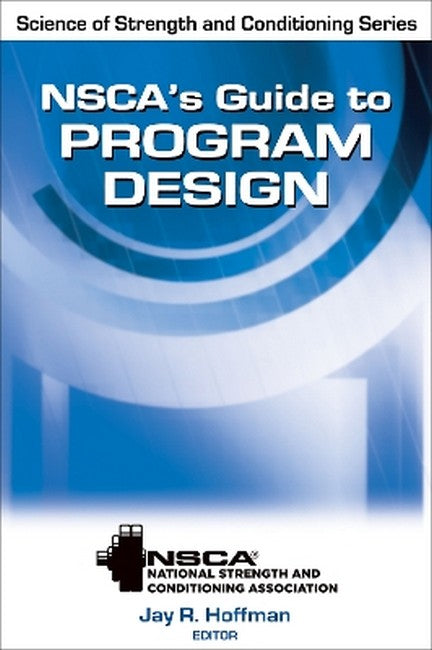Founded in 1978, the National Strength and Conditioning Association (NSCA) is an international nonprofit educational association with members in more than 56 countries. Drawing on its vast network of members, the NSCA develops and presents the most advanced information regarding strength training and conditioning practices, injury prevention, and research findings. Unlike any other organization, the NSCA brings together a diverse group of professionals from the sport science, athletic, allied health, and fitness industries. By working to find practical applications for new research findings in the strength and conditioning field, the association fosters the development of strength training and conditioning as a discipline and as a profession. Jay Hoffman, PhD, is a professor of exercise science at the University of Central Florida and coordinator of their sport and exercise science program. Long recognized as an expert in the field of exercise physiology, Hoffman has more than 150 publications to his credit in refereed journals, book chapters, and books, and he has lectured at more than 300 national and international conferences and meetings. He also has more than 17 years of experience coaching at the collegiate and professional levels. This combination of the practical and the theoretical provides him with a unique perspective on writing for both coaches and academic faculty. Hoffman was elected president of the National Strength and Conditioning Association in 2009. He was awarded the 2005 Outstanding Kinesiological Professional Award by the Neag School of Education at the University of Connecticut and the 2007 Outstanding Sport Scientist of the Year by the National Strength and Conditioning Association. He also was awarded the 2000 Outstanding Junior Investigator Award by the NSCA. He is a fellow of the American College of Sports Medicine and serves on the board of directors of the USA Bobsled and Skeleton Federation. He is the author of Physiological Aspects of Sport Training and Performance (Human Kinetics, 2002) and Norms for Fitness, Performance, and Health (Human Kinetics, 2006).
Description
Chapter 1. Athlete Needs Analysis William J. Kraemer, PhD, Brett A. Comstock, MA, James E. Clark, MS, and Courtenay Dunn-Lewis, MA Metabolic Demands of the Sport Biomechanical Demands of the Sport Injury Risks of the Sport Integrating the Needs Analysis Chapter 2. Athlete Testing and Program Evaluation Jay R. Hoffman, PhD Factors That Affect Performance Testing Test Selection Practical Considerations for Test Administration Tests for Needs Assessment and Program Evaluation Chapter 3. Dynamic Warm-Up Avery D. Faigenbaum, EdD Static Stretching and Performance Dynamic Warm-Up and Performance Developing a Dynamic Warm-Up Protocol Dynamic Warm-Up Exercises Chapter 4. Resistance Training Nicholas A. Ratamess, PhD Adaptations to Resistance Training Customizing Resistance Training Programs Resistance Training Program Variables Chapter 5. Power Training Robert U. Newton, PhD, Prue Cormie, PhD, and William J. Kraemer, PhD Factors Contributing to Power Output Targeting Power Development Training Methods for Power Development Selecting Load and Velocity for Power Development Chapter 6. Anaerobic Conditioning Jay R. Hoffman, PhD Physiological Adaptations From Anaerobic Conditioning Programs Developing Anaerobic Conditioning Programs Anaerobic Conditioning Exercises Chapter 7. Endurance Training Joel T. Cramer, PhD, and Abbie E. Smith, PhD Factors in Aerobic Endurance Performance Aerobic Endurance Training Variables Aerobic Endurance Training Strategies Periodization for Aerobic Endurance Training Chapter 8. Agility Training Lee E. Brown, EdD, and Andy V. Khamoui, MS Factors in Agility Performance Assessing Agility Training for Agility Agility Program Design Chapter 9. Speed Training Jay R. Hoffman, PhD, and John Graham, MS Factors in Speed Performance Sprinting Mechanics and Technique Speed Program Design Chapter 10. Balance and Stability Training Nejc Sarabon, PhD Program Planning and Periodization Safe Progression for Balance Exercises Stability Training for Joint Systems Chapter 11. Training Integration and Periodization G. Gregory Haff, PhD, and Erin E. Haff, MA General Principles of Periodization Training Periods Sequencing and Integration of the Training Process Practical Guidelines Chapter 12. Training Program Implementation Jay R. Hoffman, PhD, Lee E. Brown, PhD, and Abbie E. Smith, PhD Workout Sessions Off-Season Training Competitive Season Considerations for Endurance Athletes Program Evaluation

